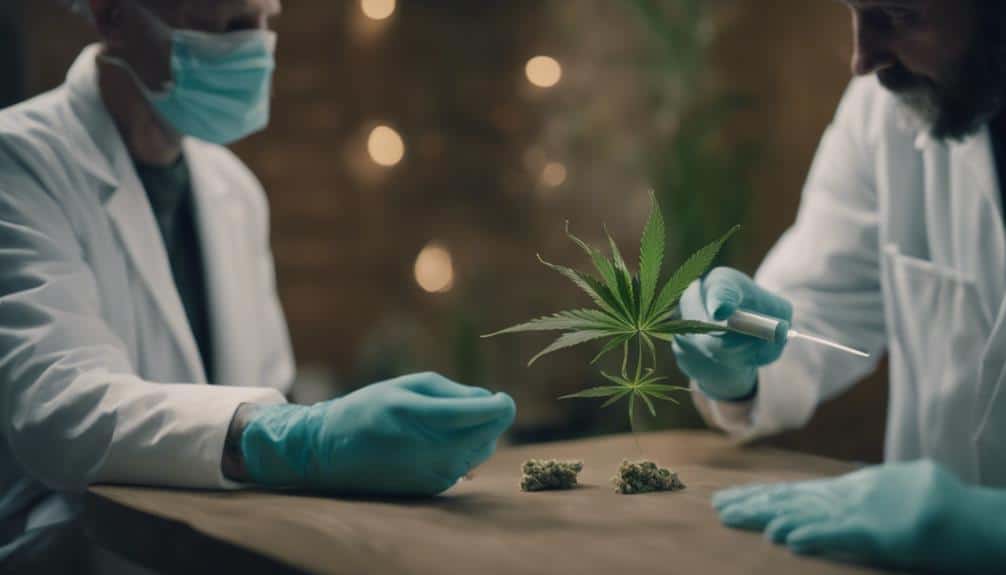When Mary, a 45-year-old teacher, found herself unable to cope with her chronic back pain, she turned to cannabis as a last resort. Now, she’s part of a growing number of people who’ve discovered the potential benefits of this plant in managing chronic pain.
Table of Contents
The landscape of pain management is shifting. But are we ready to accept this change? As you contemplate the implications, consider the prospects: could cannabis be the solution we’ve been searching for or is it simply another false dawn in our quest to conquer chronic pain?
Understanding Chronic Pain: A Synopsis

To fully grasp the role of cannabis in managing chronic pain, it’s crucial first to understand what chronic pain actually is and how it impacts your body and daily life. Chronic pain is a complex condition that often persists for months or even years. Unlike acute pain that serves as a warning system, chronic pain doesn’t stop when the underlying cause heals.
Pain mechanisms involve the nervous system which sends pain signals from the affected area to your brain. When it comes to chronic pain, these signals keep firing even when the original injury or disease has healed.
Now let’s talk about treatment alternatives. Traditional methods include over-the-counter pain relievers, opioids, and physical therapy. However, these often offer temporary relief and may lead to side effects or dependency issues. Hence there’s an urgent need for safer and more effective alternatives.
This is where cannabis enters the picture. As an emerging treatment alternative, it’s showing potential in managing chronic pain, with studies suggesting it can interfere with pain signals, providing relief. Understanding these aspects is vital for those dedicated to serving others, particularly those suffering from chronic pain.
The Opioid Crisis: A Grim Reality
While we’re on the subject of pain management alternatives, it’s crucial to acknowledge the devastating impact of the ongoing opioid crisis. This grim reality underscores the need for safer solutions like cannabis. The crisis has wreaked havoc on individuals and communities, with over 130 Americans dying daily from opioid-related overdoses according to the Department of Health and Human Services. The impact of this crisis extends far beyond health issues to social and economic aspects of society.
As you delve deeper, you’ll find that this crisis is largely driven by the over-prescription of opioid pain relievers. These medications are effective for acute pain but aren’t suitable for long-term use due to their high potential for addiction and dependence. Hence there’s a critical need for opioid alternatives.
This is where cannabis comes in. Research shows that cannabis-based products can effectively manage chronic pain without risking overdose or leading to substance abuse disorders. Ultimately integrating cannabis into pain management protocols could mitigate the opioid crisis by offering a safer and effective alternative. You’re part of this wave of change helping shift the narrative on pain management and offering hope to those grappling with chronic pain.
Cannabis: Historical Context and Modern Perception

Despite its current recognition as a potential alternative for managing chronic pain, the historical context and modern perception of cannabis have been marked by a tumultuous journey of legal battles, stigma, and evolving scientific understanding. Ancient usage of cannabis traced back as far as 5000 years reveals its roots in traditional medicine for pain relief. Yet in the 20th century, legal restrictions and societal stigma pushed it to the fringes.
Today you’re witnessing a shift. Science is steadily debunking myths contributing to stigma reduction and unveiling the therapeutic potential of cannabis. This isn’t about promoting recreational use; it’s about understanding how this plant once considered a pariah could revolutionize pain management.
Your role in this evolution is pivotal. As advocates for those in pain, it’s incumbent upon you to stay informed debunk misconceptions and promote scientific understanding. By doing so you’re not only championing a more empathetic view of cannabis but also paving the way for potential new avenues in chronic pain management. Remember the goal isn’t to replace existing treatments but to expand the toolkit providing more options for those who suffer.
Cannabis and Chronic Pain: The Science
Unraveling the complex relationship between cannabis and chronic pain current scientific research is illuminating the potential role of this plant in pain management. At heart lie cannabinoid receptors crucial components of our body’s endocannabinoid system. These receptors specifically CB1 and CB2 interact with compounds found in cannabis resulting in a range of therapeutic effects.
In terms of chronic pain relief here are some critical points:
- Cannabis particularly cannabinoids THC and CBD can modulate pain by interacting with cannabinoid receptors.
- Therapeutic dosages of cannabis can be tailored to individual needs offering a personalized approach to pain management.
- Research suggests cannabis could mitigate opioid use in chronic pain patients offering a safer less addictive alternative.
- Long-term use of cannabis in therapeutic dosages hasn’t shown significant adverse effects making it a potentially sustainable solution.
It’s important to note that while the research is promising, it’s still evolving. As you serve others understanding this complexity can help guide conversations and decisions around cannabis use for chronic pain.
Patient Testimonials: Real-life Stories

Beyond scientific research there’s compelling evidence from those who’ve tried cannabis for managing their chronic pain offering real-world insight into its effects. These patient testimonials provide an invaluable perspective shedding light on how cannabis has changed lives and underlining its testimonial impact.
One patient, a former construction worker, was reliant on opioids for years. After starting medicinal cannabis he reported a significant reduction in pain and improved sleep. His story exemplifies the power of patient advocacy.
Another testimonial comes from a woman with fibromyalgia. After being bedridden for months she turned to cannabis which she credits for her ability to engage in daily activities without unbearable pain.
A Vietnam War veteran with chronic pain from old wounds provides yet another testimonial. He found cannabis to be more effective and less debilitating than the numerous painkillers he’d been prescribed before.
While these stories aren’t clinical trials they offer a different kind of proof. They’re not just about pain relief but also about reclaiming lives from chronic pain. These testimonials underscore the need for further research and the importance of patient advocacy in pushing for accessible cannabis-based treatments.
Conclusion
As the murky waters of chronic pain and opioid addiction swirl, cannabis emerges as a beacon of hope. A historical stigma now shattered reveals a path to relief. Science echoes the testimonials validating the power of this green lifeline. It’s not just a plant but a pioneering solution disrupting the grim narrative of chronic pain. Cannabis isn’t just changing pain management it’s transforming lives. Dive into the depths of research embrace the evidence and witness the dawn of a new era in pain relief.
Before we proceed further I’d like to personally invite you to visit Doc Greenly at docgreenly.com or give us a call. We’re not just about providing information; we’re about community and understanding. We’d love to be part of your journey towards pain relief and better quality life. Together we can navigate the path to healthier future. Come join us and see how cannabis can transform your life.

